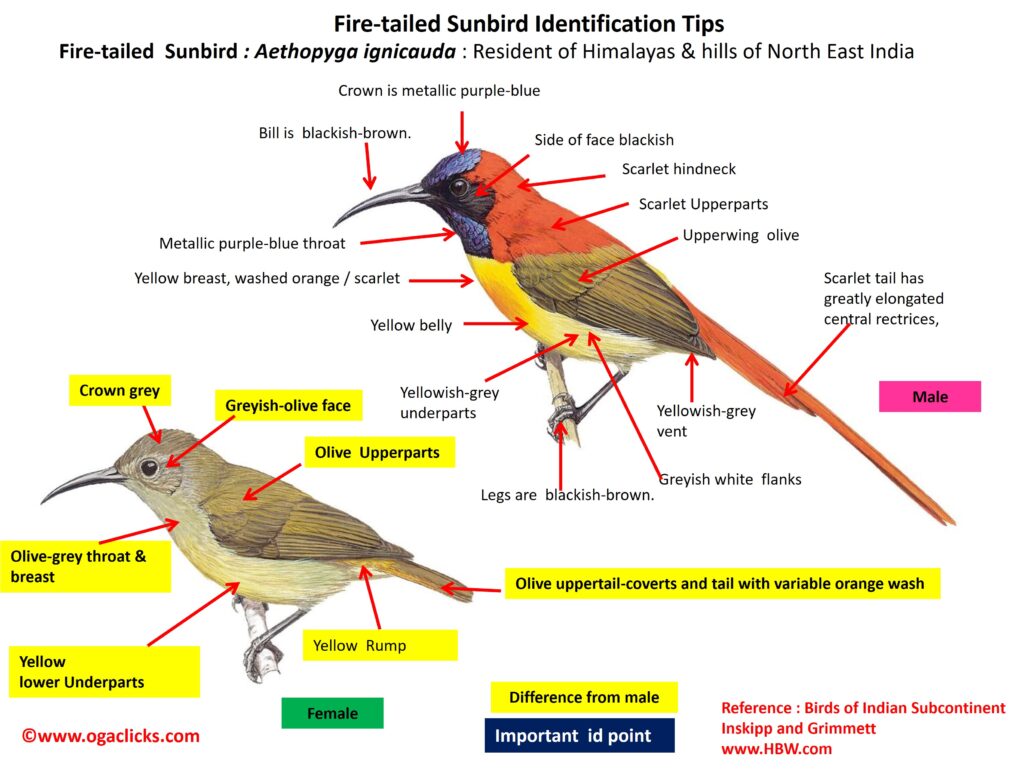
Fire-tailed Sunbird Aethopyga ignicauda
Etymology:
- Aethopyga : Greek word aithos – fire, burning heat; puge– rump
- Ignicauda : Latin word ignis fire; cauda tail
Vernacular Name: Mar: Vigorcha suryapakshi/ Shinjir
Sub-Species:
- Nominate – North & North East India (from East Himachal Pradesh East in Himalayas to Arunachal Pradesh, also Meghalaya East to Nagaland and South to Manipur)
- i. flavescens– North East India (Lushai Hills, in East Mizoram) {Male is shorter-billed than nominate, tends to have slightly smaller iridescent cap, shorter tail and much less scarlet in yellow of breast, female paler and brighter olive above than nominate, with more and brighter yellow on rump, more red on tail, brighter yellow on throat and breast}
Distribution :
- Nominate – North & North East India (from East Himachal Pradesh East in Himalayas to Arunachal Pradesh, also Meghalaya East to Nagaland and South to Manipur)
- i. flavescens– North East India (Lushai Hills, in East Mizoram)
Description :The male size is 15–20 cm,wt is 7·5–9 g; female size is 8·5–11 cm. It has a bill slightly decurved, male has striking plumage tail streamers. The male nominate race has metallic purple-blue crown, blackish side of face, scarlet hindneck and upperparts, yellow patch on lower back; tail, including greatly elongated central rectrices, also scarlet, upperwing is olive.The throat is metallic purple-blue, underparts are yellow, washed orange or scarlet on breast, and greyer towards vent. The iris is dark brown; bill and legs are blackish-brown. The female has a grey head, olive upperparts, yellow on rump, olive uppertail-coverts and tail has variable orange wash, upperwing as male, The chin to breast is olive-grey, yellow lower breast and belly, becoming whitish on vent, flanks olive; some orange on breast; bare parts as male. The juvenile is like female, but greyer on head, and tail duller olive, young male brighter yellow below and often with some red on throat and breast; first-winter male as smaller adult female, but tail longer, more yellow below, has yellow patch on back, orange-red on rump, uppertail-coverts and tail, sometimes red or orange on underparts.
Habitat: It is found in coniferous and oak forest, particularly with rhododendron understorey, also juniper scrub above tree-line. It is found from 3000–4880 m in summer, and 610–2900 m in winter.
Food habits: It eats nectar, small insects, and spiders . It forages singly and in pairs; outside breeding season also in groups, and joins mixed-species flocks. It catches insects in air.
Breeding habits: They breed in Apr–Jun in India. The nest is built mostly by female. The nest is oval, with small entrance near top, constructed from moss, rootlets, cobweb and papery bark and lined with vegetable down, fine grass and feathers, or fine seed down from fallen pods of held together with spider webs, scraps of moss and long shreds of grass, or constructed from lichen, and may be decorated with moss. The nest is suspended from branch of dwarf bamboo or bush, or attached by grass and moss to a bracken frond. They lay a clutch 2–3 eggs